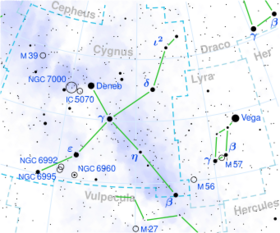41 Cygni
Topic: Astronomy
 From HandWiki - Reading time: 3 min
From HandWiki - Reading time: 3 min
| Observation data Equinox J2000.0]] (ICRS) | |
|---|---|
| Constellation | Cygnus |
| Right ascension | 20h 29m 23.73561s[1] |
| Declination | +30° 22′ 06.7968″[1] |
| Apparent magnitude (V) | 4.02[2] |
| Characteristics | |
| Evolutionary stage | supergiant[3] |
| Spectral type | F5Ib-II[3] |
| B−V color index | +0.38[2] |
| Variable type | constant[3] |
| Astrometry | |
| Radial velocity (Rv) | −18.20[4] km/s |
| Proper motion (μ) | RA: 6.89[1] mas/yr Dec.: −0.87[1] mas/yr |
| Parallax (π) | 4.24 ± 0.16[1] mas |
| Distance | 770 ± 30 ly (236 ± 9 pc) |
| Absolute magnitude (MV) | −3.32[5] |
| Details | |
| Mass | 5.3±0.4[6] M☉ |
| Radius | 27.01+2.51 −1.01[7] R☉ |
| Luminosity | 1,197±90[7] L☉ |
| Surface gravity (log g) | 2.32±0.08[6] cgs |
| Temperature | 6533+126 −283[7] K |
| Metallicity [Fe/H] | 0.00±0.07[6] dex |
| Rotational velocity (v sin i) | 9.5±2.0[3] km/s |
| Age | 85[6] Myr |
| Other designations | |
| Database references | |
| SIMBAD | data |
41 Cygni is a single[9] star in the northern constellation of Cygnus, located near the southern border with Vulpecula. It is visible to the naked eye as a faint, yellow-white hued star with an apparent visual magnitude of 4.02.[2] The star lies at a distance of around 770 light years from the Sun, based on parallax, and is drifting closer with a radial velocity of −18 km/s.[4]
This is a sharp-lined supergiant star[10] with a stellar classification of F5Ib-II.[3] It is 85[6] million years old with 5.3[6] times the mass of the Sun and is spinning with a projected rotational velocity of 9.5 km/s.[3] Having exhausted the supply of hydrogen at its core, the star has expanded to 27[7] times the Sun's radius. It is radiating about 1,200[7] times the Sun's luminosity from its swollen photosphere at an effective temperature of 6,533 K.[7]
References
- ↑ 1.0 1.1 1.2 1.3 1.4 Van Leeuwen, F. (2007). "Validation of the new Hipparcos reduction". Astronomy and Astrophysics 474 (2): 653–664. doi:10.1051/0004-6361:20078357. Bibcode: 2007A&A...474..653V.
- ↑ 2.0 2.1 2.2 Luck, R. Earle (2014). "Parameters and Abundances in Luminous Stars". The Astronomical Journal 147 (6): 137. doi:10.1088/0004-6256/147/6/137. Bibcode: 2014AJ....147..137L.
- ↑ 3.0 3.1 3.2 3.3 3.4 3.5 Gray, R. O. et al. (April 2001), "The Physical Basis of Luminosity Classification in the Late A-, F-, and Early G-Type Stars. I. Precise Spectral Types for 372 Stars", The Astronomical Journal 121 (4): 2148–2158, doi:10.1086/319956, Bibcode: 2001AJ....121.2148G
- ↑ 4.0 4.1 Gontcharov, G. A. (2006). "Pulkovo Compilation of Radial Velocities for 35 495 Hipparcos stars in a common system". Astronomy Letters 32 (11): 759–771. doi:10.1134/S1063773706110065. Bibcode: 2006AstL...32..759G.
- ↑ Kovtyukh, V. V. et al. (2012). "Accurate luminosities from the oxygen λ7771-4 Å triplet and the fundamental parameters of F-G supergiants". Monthly Notices of the Royal Astronomical Society 423 (4): 3268. doi:10.1111/j.1365-2966.2012.21117.x. Bibcode: 2012MNRAS.423.3268K.
- ↑ 6.0 6.1 6.2 6.3 6.4 6.5 Lyubimkov, Leonid S. et al. (2010). "Accurate fundamental parameters for A-, F- and G-type Supergiants in the solar neighbourhood". Monthly Notices of the Royal Astronomical Society 402 (2): 1369. doi:10.1111/j.1365-2966.2009.15979.x. Bibcode: 2010MNRAS.402.1369L.
- ↑ 7.0 7.1 7.2 7.3 7.4 7.5 Brown, A. G. A. (August 2018). "Gaia Data Release 2: Summary of the contents and survey properties". Astronomy & Astrophysics 616: A1. doi:10.1051/0004-6361/201833051. Bibcode: 2018A&A...616A...1G. Gaia DR2 record for this source at VizieR.
- ↑ "41 Cyg". SIMBAD. Centre de données astronomiques de Strasbourg. http://simbad.u-strasbg.fr/simbad/sim-basic?Ident=41+Cyg.
- ↑ Eggleton, P. P.; Tokovinin, A. A. (September 2008), "A catalogue of multiplicity among bright stellar systems", Monthly Notices of the Royal Astronomical Society 389 (2): 869–879, doi:10.1111/j.1365-2966.2008.13596.x, Bibcode: 2008MNRAS.389..869E.
- ↑ Adelman, S. J. et al. (January 2008). "Elemental abundance analyses with DAO spectrograms: XXXI. The early F supergiants ν Her (F2 II) and 41 Cyg (F5 Ib-II)". Astronomische Nachrichten 329 (1): 26–38. doi:10.1002/asna.200710863. Bibcode: 2008AN....329....4A.
 |
 KSF
KSF
